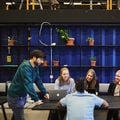Aalto Open Science Award Ceremony, May 7, 2024
Join us in celebrating the winners of the Aalto Open Science Award 2023!

The core focus of research of the Robotic Manipulation of Deformable Objects project lies in advancing the capabilities of robotic systems to manipulate deformable objects such as clothes, sponges, and food. Beyond technical implications, the work holds potential for enhancing human well-being, particularly in healthcare settings where robots could play a vital role in assistive tasks such as dressing, bathing, and feeding elderly people.
Professor and Vice Head of Department Ville Kyrki from Electrical Engineering and Automation, Postdoctoral Researcher Tran Nguyen Le, and Assistant Professor (Tampere University) and Visiting Researcher (Aalto University) Gökhan Alcan talked about their research and described how open science is part of their everyday research practices.
Robotics research is important, because robotics is a generic approach of building machines that are capable of some level independent and intelligent behavior, and they can be applied across a wide number of application problems. The research topics of the group range from robotic grasping and manipulation to the intersection of learning and control as well as safety.
One constant challenge in robotics is daily live deployment. We are still quite far away from robots being capable of doing autonomous tasks. Robots are currently more typically used in constrained settings, where circumstances do not change, unlike in real life. For a long time, it has been possible to have a robot to empty a dishwasher in a certain kind of kitchen, but to deploy it to any kitchen, is still far away.
Robotic hands have been tested with actual people in the laboratory environment, but since health care industry is a heavily regulated area, there is a long way to go from even having a technology, not to mention having a product that could be sold and used.
The group has actively shared their research outcomes with the scientific community. They have curated open access datasets and disclosed hardware designs, ensuring that fellow researchers can easily integrate the group’s resources into their own projects. Furthermore, the commitment of the group extends to making their scientific contributions available as open access articles and open-source software. The group has also reused publicly available data.
In hardware design, standardized object datasets such as YCB dataset play a crucial role. If every laboratory used the same kind of objects such as mugs, the results would be easier to compare. Then the best solution could be taken as a starting point, and you could build iteratively on earlier results or design. Availability of datasets depends on the problem. There is a big community with good quality datasets for grasping of rigid objects for instance, but for smaller areas where the application potential is also smaller, finding good quality datasets is harder. For example, there are no datasets for deformable objects for now.
In the past ten years, robotics research community has started to adopt open science practices more extensively. People have started to see the benefits of opening the research: the more you open, the more you have impact.
However, there is some variation in the level of openness according to the funder. In Research Council of Finland’s projects basically everything can be opened, whereas in contract research with industry the companies want to limit the openness to safeguard the competitive advantage.
Opening not only publications but also source code, algorithms, and lectures as Youtube videos is a win-win solution for everyone. Because the information is openly available, there is no need to invest so much time to adapt the state of the art of the research. On the other hand, opening the research is not without cost, because curating the material requires extra work. It is also important to appreciate quality over quantity in opening the data. Well curated good quality data attracts collaboration and benefits the community.
There is no data repository specified in robotics research. Research data is typically published along with the paper, which is a challenge to data persistence. The source code is shared in GitHub.
One of the barriers is that there is no standardized equipment. Every lab has their own robot, so it is hard to compare the results. This forms a big challenge for reproducibility. Sharing hardware design can help with tackling this problem.
Another challenge is the time and effort needed for opening the research. It is surprising how much time releasing a good quality code can take.
One direct enabler for open science are the open access agreements of Aalto University. Pre-print services such arXiv are also an important enabler. They allow fast and direct publishing, which is important in technological fields that evolve so fast that the technology might become obsolete, if you need to wait for a year to get published. The disadvantage of pre-prints is the lack of review, which can make them in a way as a barrier to open science at the same time.
The robotics community is already rather open. Within Europe it is easier to collaborate with others, but in collaborations outside of Europe, more funding for opening research is needed.
Openness should be considered in the researcher assessment along with other factors, but the quality of opened outputs should be also considered.
Initiatives such as Open Science Award are important in making researchers aware of each other’s work. Examples presented might encourage others to adopt open science practices such as publishing code, although it requires work. The basic rule could read as follows: if you spend time on it, share it.
The culture starts from the supervisor. If supervisor encourages collaboration and openness, it is likely that group members will adopt similar practices.
Personal data is not a big concern in robotics research. In certain research settings robots may have sensors such as cameras and record videos, where people might accidentally appear. In these cases, image processing tools are used to blur faces. When conducting user studies where humans and robots do things together, personal data is gathered, but not released.
Dual use and export control could pose challenges to the openness in the future because robotics is classified as a potentially sensitive technology. Robot grasping fundamental research is not probably the most sensitive research area, but there are subfields that may be more prone for dual use. However, predicting how things will evolve is very difficult and depends on geopolitics.
As for the robotics community, the future of open science looks bright. The community already sees open science beneficial. Open science evolves faster in software than in hardware, but development is happening there as well. If your group encourages open science, it is better known in the community, and hence, it can also attract talents.
N. Tuomainen, D. Blanco-Mulero, and V. Kyrki. Manipulation of granular materials by learning particle interactions. IEEE Robotics and Automation Letters, vol. 7, no. 2, pp. 5663–5670, 2022. DOI: 10.1109/LRA.2022.3158382.
T. N. Le, J. Lundell, F. J. Abu-Dakka, and V. Kyrki. Deformation-aware data-driven grasp synthesis. IEEE Robotics and Automation Letters, vol. 7, no. 2, pp. 3038–3045, 2022. DOI:10.1109/LRA.2022.3146551.
H. Wang, F. J. Abu-Dakka, T. Nguyen Le, V. Kyrki, and H. Xu. A novel soft robotic hand design with human-inspired soft palm: Achieving a great diversity of grasps. IEEE Robotics Automation Magazine, vol. 28, no. 2, pp. 37–49, 2021. DOI: 10.1109/MRA. 2021.3065870.
D. Blanco-Mulero, Evolving-graph gaussian processes, https://github.com/dblanm/evolvingggp, 2021.
T. Nguyen Le, Deformation-aware data-driven grasp synthesis, https://github.com/trannguyenle95/defggcnn, 2022.
D. Blanco-Mulero, Manipulation of granular materials by learning particle interactions, https://github.com/dblanm/gnn-manip, 2022.
H. Wang, A novel simulation-based quality metric for evaluating grasps on 3d deformable objects, https://irobotics.aalto.fi/a-novel-design-of-soft-robotic-hand-with-a-human-inspired-soft-palm-for-dexterous-grasping/ 2022.
This interview is a part of a series showcasing the Aalto Open Science Award winner and runners-up. We warmly welcome you to the Open Science award ceremony which will take place on the 7th of May 2024.
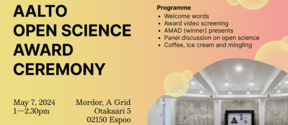
Join us in celebrating the winners of the Aalto Open Science Award 2023!
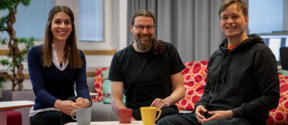
We interviewed the AMAD team, winners of the first Aalto Open Science Award.
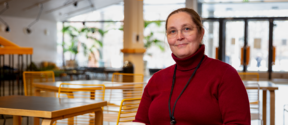
We interviewed professor Riikka Puurunen, head of Catalysis research group at the School of Chemical Engineering, who received an honorary mention in the first Aalto Open Science Award.
The principle of openness is the key principle of science and research. At Aalto University, the most visible forms of open science are open access publications, open research data and metadata, and combining openness and commercialisation.

Properly managed research data creates competitive edge and is an important part of a high-quality research process. Here you will find links to support, services and instructions for research data management.

We offer free and open to all training in research data management and open science.
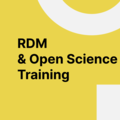
Data Agents are researchers who work to improve data management in their department, school, or unit.
